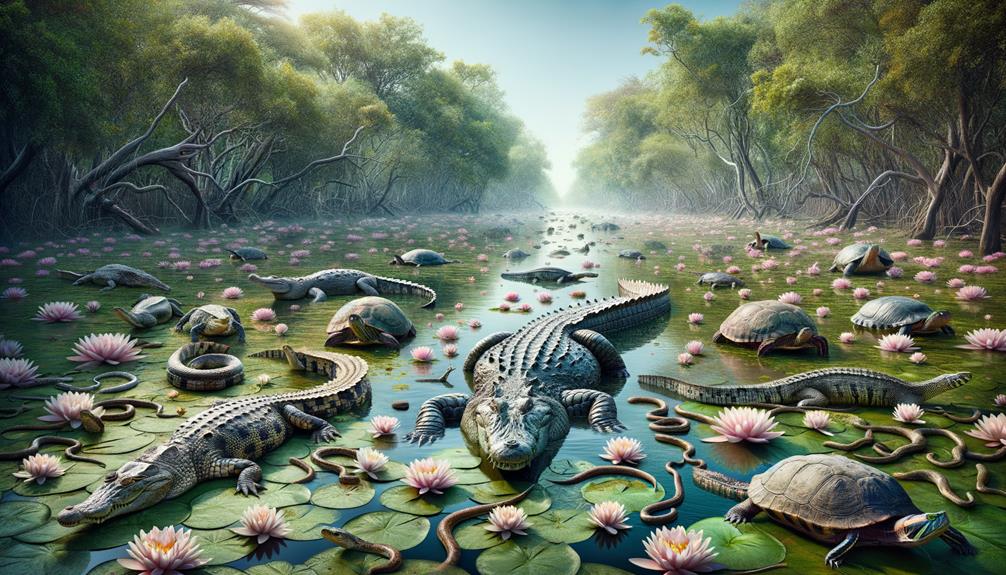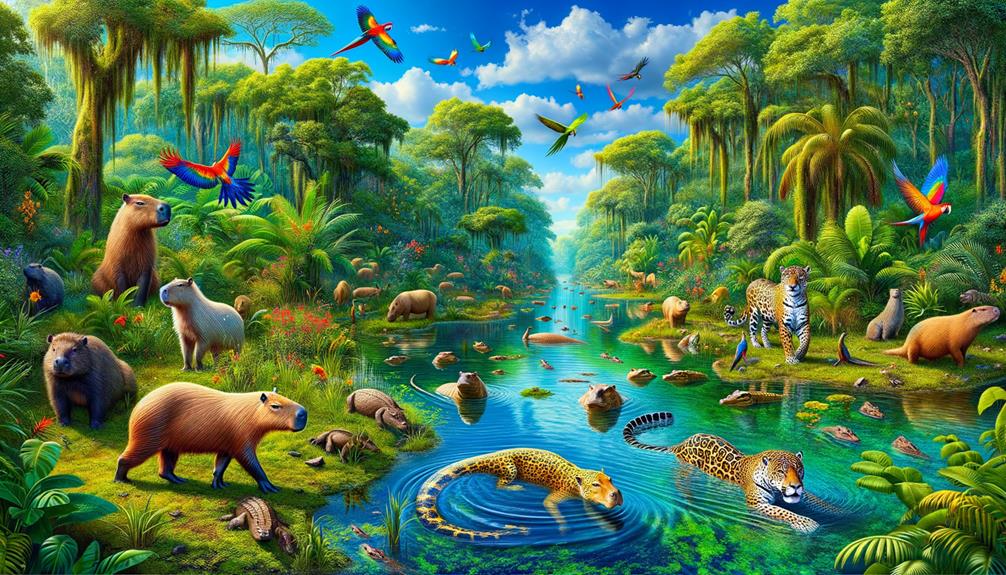The Everglades is a vibrant ecosystem where a diverse range of reptiles, including American alligators and crocodiles, flourish. Once on the brink of extinction, alligators now dominate freshwater marshes, while crocodiles have made coastal mangroves their own. Snakes, such as the Florida cottonmouth and banded water snake, play a vital role in maintaining the ecosystem's delicate balance. Unfortunately, human activities like urban development and the introduction of invasive species, including Burmese pythons, disrupt this fragile ecosystem. Conservation efforts focus on restoring natural water flows and managing habitats. As ecosystem engineers, reptiles ensure the survival of many species. They maintain the Everglades' ecological harmony, and their importance cannot be overstated.
Key Takeaways
American alligators and crocodiles sit atop the Everglades food chain, playing a vital role in maintaining the ecosystem's delicate balance.
The diverse range of habitats within the Everglades, including freshwater marshes and brackish mangrove forests, supports a wide variety of reptile species. Each of these species has evolved unique adaptations to thrive in its specific environment.
Efforts to restore the Everglades, such as the Everglades Restoration Plan, focus on reestablishing natural water flows and protecting the habitats of reptiles and other species.
Invasive species like Burmese pythons pose a significant threat to the ecosystem, competing with native reptiles for resources and disrupting the balance.
Reptiles play a crucial dual role in the Everglades ecosystem, serving as both predators and prey. This helps regulate animal populations and maintain the overall health of the ecosystem.
Key Reptile Species
When exploring the unique ecosystem of the Everglades, it's crucial to acknowledge the key reptile species that define this environment and highlight the success of conservation efforts. The American alligator, once on the brink of extinction, now flourishes throughout Florida's wetlands, with some reaching up to 15 feet in length. This remarkable recovery is a testament to the resilience of the Everglades.
The American crocodile, found in South Florida's coastal regions, is equally impressive. With its long, narrow snout, it can grow up to 20 feet in length, showcasing the diverse reptilian life the Everglades supports. Meanwhile, the non-venomous banded water snake is often mistaken for its venomous counterpart, the Florida cottonmouth, due to their similar coloration and size, which can reach up to 42 inches.
However, it's the Florida cottonmouth, the most common venomous snake in Florida, that demands caution. Its hemotoxic venom poses a serious threat, highlighting the delicate balance of danger and beauty in this ecosystem. Together, these species illustrate the intricate web of life that makes the Everglades a thriving haven for reptiles.
Habitat and Adaptations
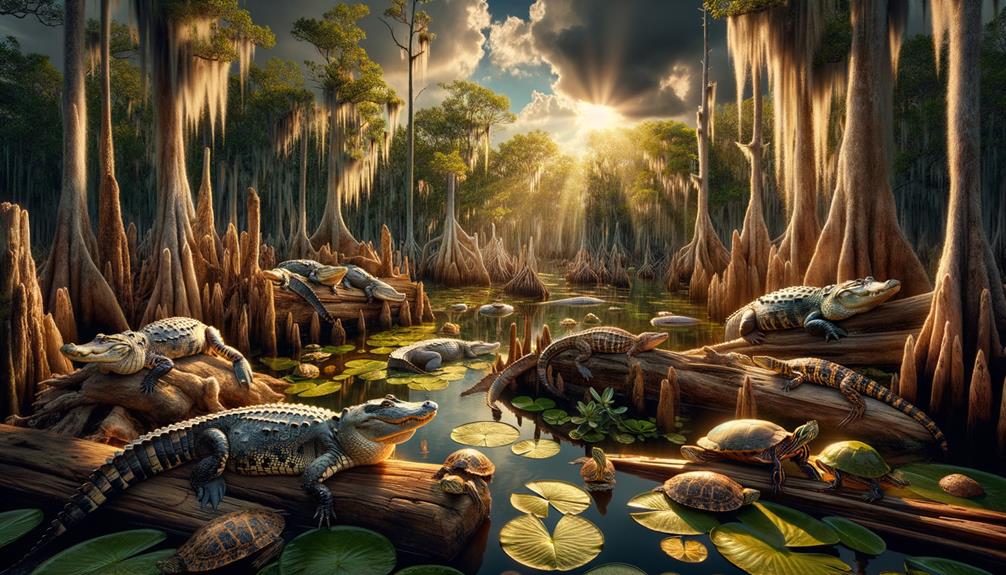
When I think of the Everglades, I'm immediately struck by the diverse range of wetland environments that support a unique array of reptile inhabitants. Take alligators and crocodiles, for example – they've developed remarkable adaptations to survive in this region's unique hydrological conditions. Similarly, banded water snakes and Florida softshell turtles have evolved specialized features that enable them to navigate these wetlands with ease. The Florida Cottonmouth, in particular, has developed an impressive set of adaptations, including heat-sensing pits that allow it to detect prey and thrive in this intricate ecosystem.
Diverse Wetland Environments
Examining the Everglades' diverse wetland environments reveals a complex network of habitats where reptilian species have developed unique adaptations to thrive. In freshwater marshes, alligators reign supreme, their powerful jaws and keen senses making them apex predators. In contrast, the brackish waters of coastal mangrove forests are home to the American crocodile, showcasing the adaptability within the Everglades ecosystem.
Everglades National Park provides a sanctuary for these species, safeguarding a variety of wetland habitats. However, habitat loss remains a pressing concern, threatening the delicate balance of the ecosystem. The Florida softshell turtle exemplifies adaptation, with its streamlined shell and powerful claws allowing it to navigate lakes, ponds, and canals with ease in search of aquatic prey.
Banded water snakes and Florida cottonmouths illustrate the ecological diversity of the Everglades, each occupying distinct niches. While banded water snakes hunt fish and amphibians in the wetlands, cottonmouths prefer the drier upland areas. These reptiles, along with various turtles, snakes, and lizards, maintain the ecological balance, acting as both predators and prey. Their survival highlights the resilience and complexity of the Everglades' diverse wetland environments.
Unique Survival Strategies
In the Everglades, reptiles have developed a range of strategies to survive and thrive in this unique ecosystem. American alligators, for example, regulate their body temperature by basking in the sun or retreating to cooler waters, allowing them to stay active and defend their territory.
The invasive Burmese pythons have shown remarkable adaptability, surviving in various habitats, including wetlands, grasslands, and urban areas. Their presence has disrupted the ecological balance of the Everglades, posing a significant threat to native wildlife.
Florida softshell turtles are well adapted to their aquatic environment. Their flat, streamlined shells and webbed feet enable them to swim efficiently and hide quickly in soft sediments, protecting them from predators.
The Florida cottonmouth snake has developed a unique predation technique, using specialized heat-sensing pits on its head to detect prey. This adaptation allows it to hunt effectively in both water and on land, ensuring a steady food supply.
Seasonal Behavior Changes
As the seasons change in the Everglades, reptiles exhibit fascinating adaptations and behavioral changes to survive in this dynamic ecosystem. During the wet season, alligators congregate in deeper water areas to regulate their body temperature and avoid drying out. They become particularly vocal, with the American alligator's distinctive bellow echoing through the wetlands to attract mates and defend territories.
Crocodiles, including the iconic American Crocodiles of south Florida, adjust their foraging patterns to capitalize on the surge in prey availability near coastal regions like Florida Bay. This strategic move allows them to take advantage of the wet season's bounty. Turtles, such as the Florida softshell, emerge from their buried positions to bask and hunt in the shallows, making the most of the wet season's abundance.
Snakes, like the Florida cottonmouth, also increase their activity, moving more frequently and breeding more during the warmer, wetter months. These behaviors illustrate the intricate balance these reptiles maintain with their environment. By adapting to seasonal changes, alligators, crocodiles, and other reptiles effectively navigate the challenges posed by natural predators and fluctuating conditions in the Everglades, ensuring their thriving presence in this unique ecosystem.
Impact of Human Activity
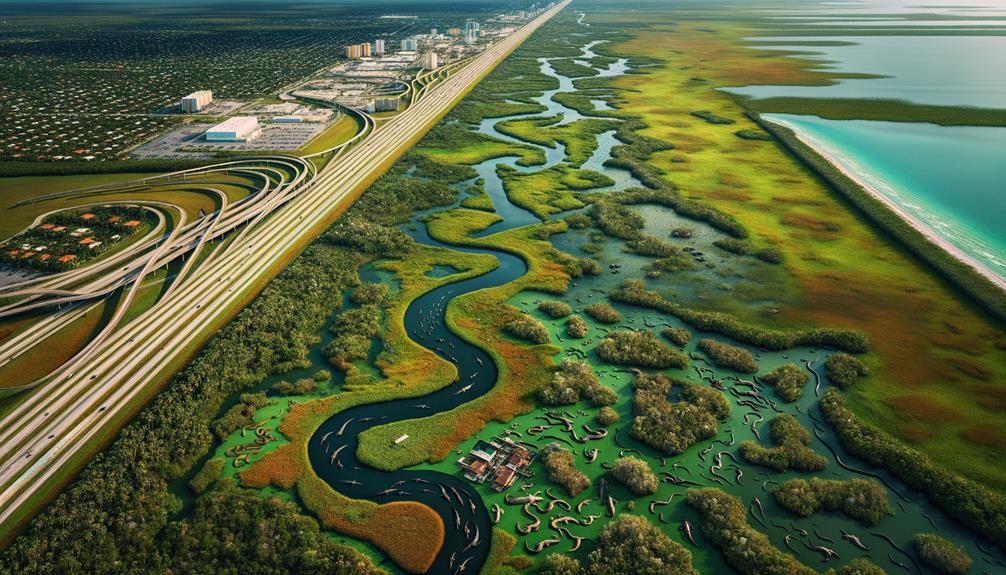
Human activities have drastically reduced the Everglades' original size, putting immense pressure on native reptiles. Invasive species and agricultural pollution have further complicated their survival. To reverse some of the damage, conservation efforts like the Essential Everglades Restoration Plan are crucial for maintaining a balanced ecosystem.
Habitat Destruction Consequences
The relentless march of urban development, agricultural expansion, and drainage projects has ravaged the Everglades, threatening the very survival of its native reptile species. Human activity has drastically altered water quality and disrupted the natural hydroperiod, which is essential for many reptiles that depend on specific water levels and seasonal flooding. These changes have led to significant habitat loss, particularly impacting coastal mangroves and freshwater wetlands.
Rising sea levels due to climate change are further exacerbating the issue, causing saltwater intrusion into these critical habitats. This shift is threatening the delicate balance of the ecosystem, forcing reptiles to adapt or face extinction. The introduction of invasive species like Burmese pythons and Argentine tegus is also creating fierce competition for resources, further endangering native reptiles like the American crocodile.
Pollution from agricultural runoff and urban sprawl is degrading water quality, harming aquatic species and their prey. The Everglades Restoration efforts aim to counteract these impacts, but success requires immense coordination and commitment. It's clear that human activity has left an indelible mark on this once-thriving ecosystem, and without immediate action, we risk losing its unique reptilian inhabitants forever.
Conservation Efforts Importance
Conservation efforts in the Everglades are crucial in the face of habitat destruction. Human activities like drainage and development have significantly damaged this ecosystem, leading to habitat loss. However, restoration projects are underway to reverse these impacts. Restoring natural water flows is vital for reptiles like the American alligator and American crocodile, as well as the entire Greater Everglades ecosystem.
The introduction of invasive species, such as the Burmese python and Argentine black and white tegu, has made the situation more complicated. These predators compete for resources and prey on native hatchlings, making conservation efforts even more critical. Comprehensive restoration plans that address water quality and quantity issues are necessary for maintaining the hydrological conditions required for these reptiles to thrive.
Monitoring and management programs, including headstarting initiatives for endangered species, are vital. These efforts ensure the long-term survival of reptiles and other wildlife, such as the Florida Black Bear, Florida panthers, and the wood stork, all found in Everglades National Park. Conservation is key to the future of this intricate, interconnected ecosystem.
Conservation Efforts
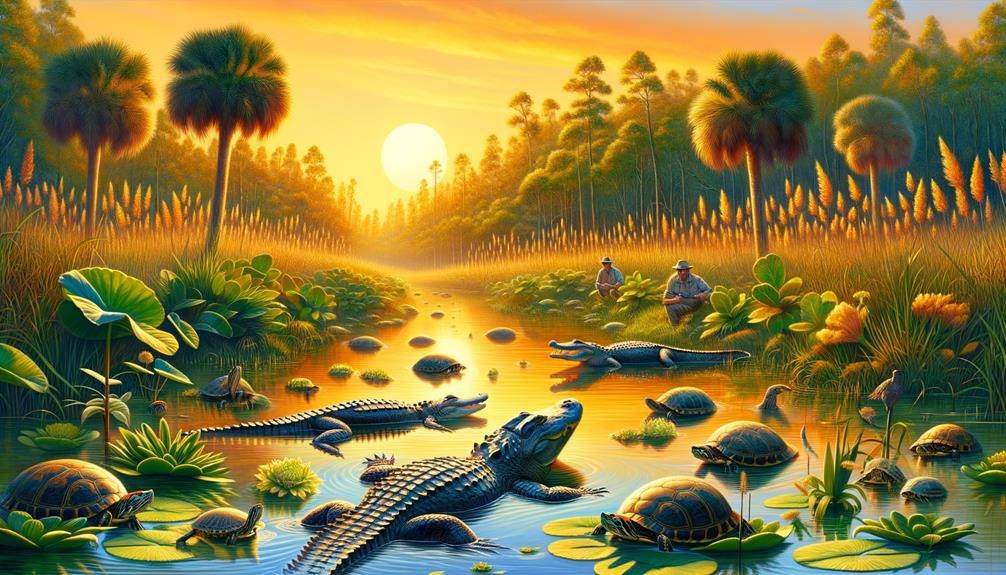
Conservation efforts in the Everglades are multifaceted and robust, focusing on restoring natural water flows, managing invasive species, and preserving critical habitats to ensure the survival of native reptiles and their ecosystems. The Extensive Everglades Restoration Plan is at the heart of these initiatives, aiming to restore the historical flow of water that sustains south Florida's rich biodiversity. This is crucial for the survival of native plants and animals, including wading birds found only in this region.
To achieve this, several key efforts are in place:
Invasive species management programs actively remove non-native reptiles like Burmese pythons and Argentine tegus, which threaten local wildlife.
Critical nesting and foraging grounds for endangered species, such as the American crocodile, are protected and preserved.
Prescribed burning practices maintain the health of fire-dependent ecosystems like pine rocklands, ensuring resilient habitats.
Ongoing research studies focus on understanding climate change impacts, sea level rise, and other threats to Everglades reptiles and their habitats.
Through these efforts, the flow of water in brackish regions and Hardwood hammocks is carefully managed, creating a thriving environment that supports a diverse array of life forms.
Role in the Ecosystem

Reptiles play a vital role in the Everglades' intricate web of life. American alligators and crocodiles, found throughout the Everglades and extending to the Florida Keys, are known as ecosystem engineers. Through their foraging and nesting activities, they create alligator holes that provide essential habitats for a diverse range of plants, aquatic mammals, bird species, and small mammals.
| Reptile | Role |
|---|---|
| American Alligator | Ecosystem Engineer |
| Crocodile | Ecosystem Engineer |
| Snakes | Predators of small mammals and insects |
| Turtles | Control small animal and insect populations |
| Lizards | Prey for birds and small mammals |
Snakes, turtles, and lizards, scattered throughout this complex environment, regulate populations of small mammals and insects, acting as both predators and prey. This balance is crucial to maintaining the overall health of the ecosystem. For example, certain reptile species prey on invasive species, helping to preserve native flora and fauna.
The presence of a diverse reptile community is a strong indicator of the Everglades' ecological health. Reptiles serve as crucial components of the food web, influencing the distribution and abundance of other species. Their interactions with the environment highlight the interconnectedness of life in the Everglades.
Future Outlook
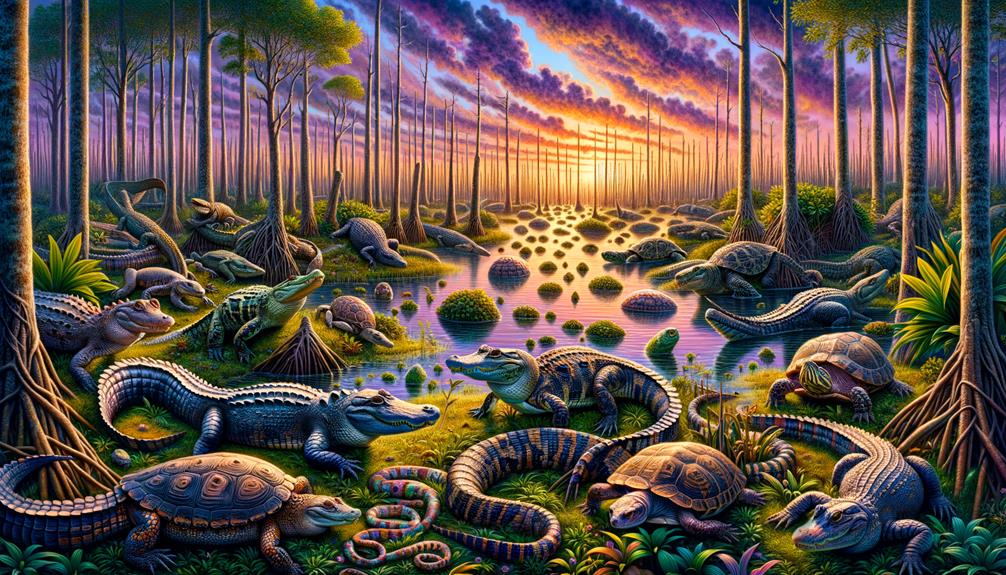
The future of Everglades reptiles hangs in the balance, and our ability to restore and maintain their habitats, improve water quality, and combat invasive species will be crucial. As urban development encroaches on the Everglades, preserving critical areas like the Marl Prairies and coastal prairies becomes increasingly vital.
To ensure a thriving ecosystem, we need to focus on several key areas:
- Habitat Restoration: Restoring the natural flow in the Everglades will have a direct benefit for native reptiles like the American alligator and the American crocodile.
- Water Quality: Clean water is essential for the survival of both reptiles and the broader wildlife community, including species like the snail kite and white-tailed deer.
- Invasive Species Control: Controlling invasive species, such as Burmese pythons, is critical to protecting native reptile populations.
- Research and Monitoring: Ongoing research and monitoring will provide valuable data, allowing us to refine conservation strategies and address emerging threats.
Collaboration between scientists, land managers, and local communities will be essential. By working together, we can safeguard the ecological health of the Everglades for generations to come.
Frequently Asked Questions
What Dominates in the Everglades Ecosystem?
Did you know that the American alligator population has made a remarkable comeback, with adults now reaching up to 15 feet in length? This impressive recovery is a testament to the success of conservation efforts in the unique Everglades ecosystem, where these massive reptiles hold sway.
What Animals Live in the Everglades Ecosystem?
In the Everglades, I've encountered a stunning array of animals, including alligators, crocodiles, various snake species, and turtles. Each one plays a vital role in this intricate ecosystem, showcasing nature's resilience and beauty.
What Are the Ecosystem Services of the Everglades?
The Everglades provide vital ecosystem services, including water purification, replenishing the aquifer, reducing flood risk, and shielding the coast. This unique ecosystem also supports farming, fishing, and wildlife, including the endangered Florida panther. Preserving the Everglades is crucial for the environment and our well-being.
How Do Animals Survive in the Everglades?
I'm amazed by the resourcefulness of animals in the Everglades. They've developed clever adaptations to survive, like alligators regulating their body temperature and softshell turtles digging burrows. Thanks to conservation efforts and these unique traits, they're able to thrive despite the challenges, maintaining a balanced and vibrant ecosystem.


